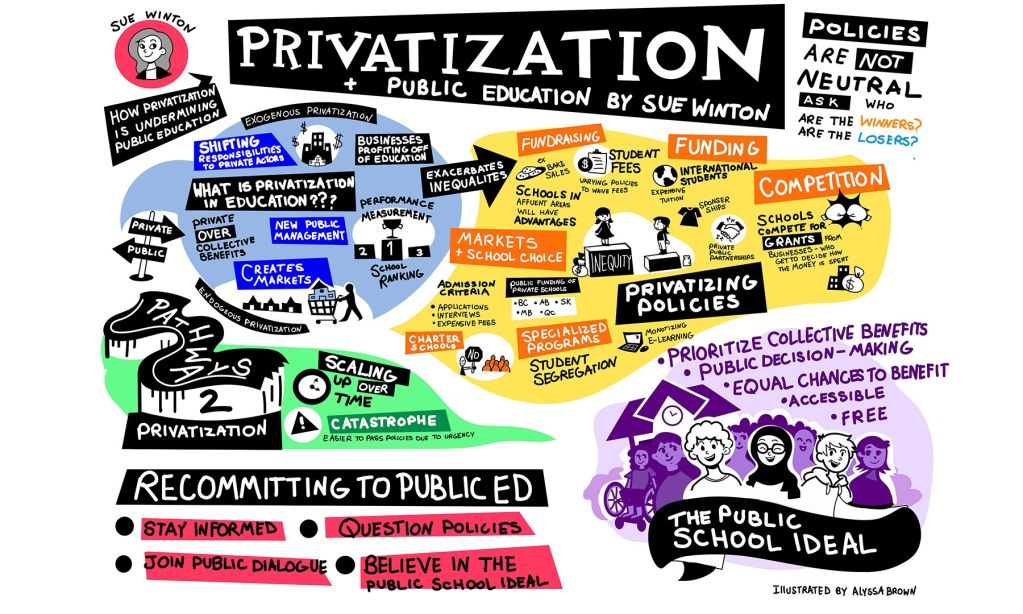In March 2023 Manitoba’s Minister of Government Services, James Teitsma, announced the government’s plan to enter into an agreement with a private company to build and maintain nine schools in the province. He claimed that this approach, a public-private partnership (P3), would enable the schools to be built more quickly and at a lower cost than would be the case if a traditional model was used. He promised that problems with P3s experienced by other governments would be avoided.
Response to the announcement was swift, with multiple actors and groups raising concerns about the government’s plan.
It’s important to highlight that public-private partnerships have many variations. In general, a public-private partnership involves an agreement between the government and an actor from the private sector to deliver a product or project wherein both parties are expected to share costs, risks, and rewards. Private sector actors who participate in P3s may include for-profit businesses, foundations, post-secondary institutions, other non-government organizations, and regular citizens.
P3s have a lot of variations. In education, they’ve been used to pay for private schooling, to top up public funding of public schools, to provide space for instruction, and to finance, design, construct, and maintain infrastructure. When they’re used to build schools, governments typically lease the space from the company that built them for a specific period of time. After the lease ends, the government may be able to buy the buildings. According to the Minister’s announcement, Manitoba plans to use a single contractor to construct and maintain nine schools for 30 years.
Motives for governments to enter into P3s to build infrastructure also vary. Sometimes a new building is needed but the government doesn’t have the money to pay for it and may think it unwise—or politically inconvenient—to borrow funds. The government may also believe that the infrastructure will be built faster since it doesn’t have to negotiate discrete contracts for the finance, design, and build aspects of the project (this is the usual way public infrastructure projects unfold).
This latter rationale has been offered by Manitoba’s Government Services Minister James Teitsma: “The purpose of bundling the schools together is to really accelerate the time frame and to ensure that we get more schools built more quickly”. The built-in assumptions here are that expedited contracting and building processes will lead to cost savings, and that the private actor assumes the risk of delays, cost overruns, or maintenance problems. Perhaps more discreetly, it also enables the government to “‘kick the can down the road’ to future administrations” while appearing more fiscally responsible to voters.

New Brunswick, Nova Scotia, Saskatchewan, and Alberta have all used P3s to design, build, finance, and/or maintain schools. New Brunswick used this approach in 1994 to build the Evergreen Park School. Nova Scotia’s government followed, announcing in 1997 it planned to use P3s to build and manage 39 schools. Various governments in Alberta have engaged this approach since 2008 to build over 40 schools, although in December 2022 the current government announced it had changed its mind about using the P3 model going forward. Saskatchewan announced in 2013 it would use a P3 to construct 18 school buildings. Information about the outcomes and on-going experiences of the infrastructure P3s comes mainly from Auditor General reports, studies by public sector unions, research by the Canadian Centre for Policy Alternatives, news reports, and subsequent decisions by governments. These reports and announcements provide important insights into how well P3s achieve their promises as well as the perils of these arrangements for the public.
The P3 model in New Brunswick, Nova Scotia, Saskatchewan, and Alberta resulted in quick construction; however, the promise that these partnerships would save the public money has often gone unrealized. New Brunswick’s Auditor General, for example, found that using a P3 to build the Evergreen School cost almost $775,000 more than it would have using traditional approaches. In 2014, Alberta cancelled the previous government’s plans to use P3s as “It was determined that using a P3 method to deliver the 19 schools would cost $570.7 million, whereas the cost would be $556.6 million through traditional procurement methods.”
Additional costs to the public have appeared after the P3 schools opened. For example, the Calgary Board of Education had to pay over $100,000 to fix a leaky roof in a school—within months of its opening—built by a private company. Staff in Edmonton reported maintenance delays that created safety risks in some schools. Rather than wait for contractors, board staff sometimes do the work themselves, meaning the public actually pays twice for the same fix. In Nova Scotia, the Auditor General reported that two contractors paid by the government to maintain their schools actually subcontracted this work back to the school boards at a higher price, netting them $52 million. By the time the NS Auditor General’s report was released in 2010, the P3 program had already been cancelled in recognition that schools could be built less expensively using the traditional method.
Other public costs of P3s have included challenges accessing the facilities. A contractor in Nova Scotia, for example, increased fees for community groups to rent school space after hours from $7/hour to $57/hour. Groups in Alberta faced similar problems, and community members complained that contract terms preventing the board from leasing school space to other organizations meant there was no way to address communities’ preschool or daycare needs. In Saskatchewan, teachers at one P3 school weren’t allowed to open classroom windows and could only cover 20% of the walls—which, as anyone familiar with today’s classrooms knows, is a huge restriction.
Manitoba’s Government Services Minister promises the government will avoid the “mistakes” of governments elsewhere, but hasn’t explained how they plan to do so. And while the province may still be working out the details, the lack of information points to other known problems of P3s for the public: accountability and transparency. Confidentiality protections of private sector contracts makes it difficult for the public to determine whether it is really getting a better deal through the P3 approach. When CCPA-NS couldn’t get access to the terms of agreement for P3 contracts to determine how much the private sector partners netted through their arrangements, they raised the question: “Should the protection of a private corporation’s private interests trump the public’s interest?”
Manitoba’s government seems aware of the perils of using P3s for schools and yet clings to the (often unrealized) promise that they offer a good deal for the public. Manitobans expect more than rapidly-constructed buildings from their leaders, however. They deserve public spaces that put students’ and communities’ needs above profits and processes that put transparency before private interests.






